torque Oldsmobile Aurora 1998 Owner's Manuals
[x] Cancel search | Manufacturer: OLDSMOBILE, Model Year: 1998, Model line: Aurora, Model: Oldsmobile Aurora 1998Pages: 380, PDF Size: 19.75 MB
Page 96 of 380
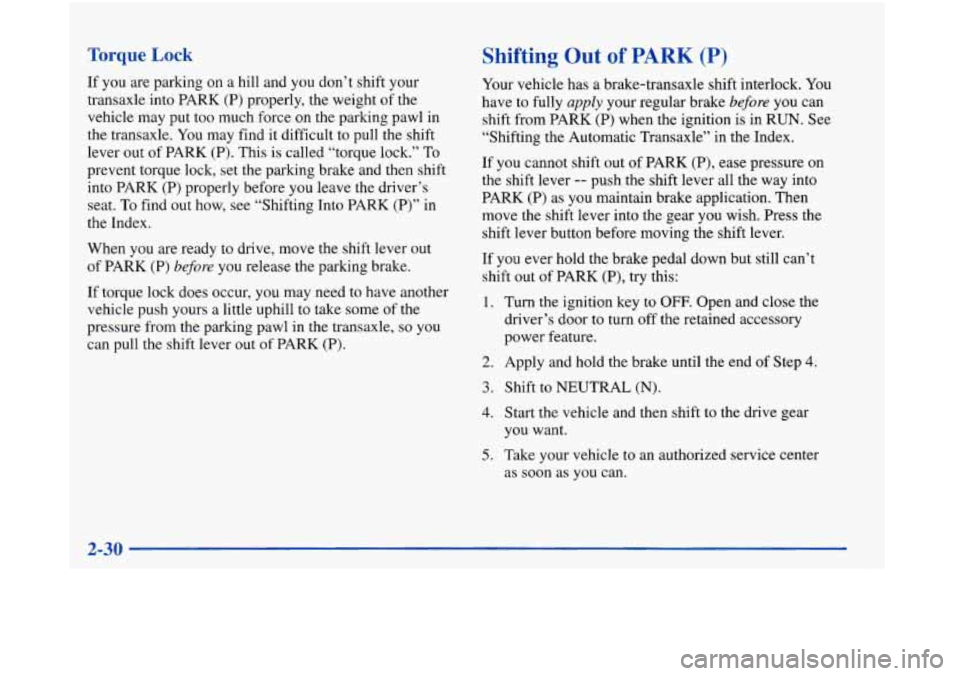
Torque Lock
If you are parking on a hill and you don’t shift your
transaxle into PARK
(P) properly, the weight of the
vehicle may put too much force on the parking pawl in
the transaxle. You may find it difficult to pull the shift
lever out of PARK (P). This is called “torque lock.”
To
prevent torque lock, set the parking brake and then shift
into PARK (P) properly before you leave the driver’s
seat.
To find out how, see “Shifting Into PARK (P)” in
the Index.
When you are ready to drive, move the shift lever out
of PARK
(P) before you release the parking brake.
If torque lock does occur, you may need to have another
vehicle push yours a little uphill to take some of the
pressure from the parking pawl in the transaxle,
so you
can pull the shift lever out
of PARK (P).
Shifting Out of PARK (P)
Your vehicle has a brake-transaxle shift interlock. You
have to fully
apply your regular brake before you can
shift from PARK (P) when the ignition
is in RUN. See
“Shifting the Automatic Transaxle” in the Index.
If you cannot shift out of PARK
(P), ease pressure on
the shift lever
-- push the shift lever all the way into
PARK
(P) as you maintain brake application. Then
move the shift lever into the gear you wish. Press the
shift lever button before moving the shift lever.
If you ever hold the brake pedal down but still can’t
shift out
of PARK (P), try this:
1. Turn the ignition key to OFF. Open and close the
driver’s door
to turn off the retained accessory
power feature.
2. Apply and hold the brake until the end of Step 4.
3. Shift to NEUTRAL (N).
4. Start the vehicle and then shift to the drive gear
you want.
5. Take your vehicle to an authorized service center
as soon as you can.
Page 246 of 380

9. Replace the wheel nuts
with the rounded end
of
the nuts toward the
wheel. Tighten each nut
by hand until the wheel
is held against the hub.
If a nut cannot be
tightened by hand, use
the wrench, and see your
retailer right away.
10. Lower the vehicle by rotating the wheel wrench to
the left on the jack. Lower the jack completely.
11. Using the wheel
wrench, tighten the
wheel
nuts firmly
in a crisscross
sequence
as shown.
1 CAUTION:
Incorrect wheel nuts or improperly tightened
wheel nuts can cause the wheel to become loose
and even come
off. This could lead to an accident.
Be sure to use the correct wheel nuts.
If you have
to replace them, be sure to get new
GM original
equipment wheel nuts.
Stop somewhere as soon as you can and have
the nuts tightened with a torque wrench to
100 lb-ft (140 Nom).
I
5-30
Page 247 of 380

I
NOTICE:
Improperly tightened wheel nuts can lead to
brake pulsation and rotor damage.
To avoid
expensive brake repairs, evenly tighten the wheel
nuts in the proper sequence and to the proper torque specification.
12. Then replace the wheel cover. Be sure to position
the alignment pin
on the cover with the notch in the
wheel. Apply pressure around the edge
of the cap to
snap it in place. Do not use a hammer or mallet to
install the cover.
Don’t try to put the wheel cover on the compact
spare tire. It won’t fit. Store the wheel cover in the
trunk
until you have replaced the compact spare tire
with a regular tire.
I NOTICE:
Wheel covers won’t fit on your compact spare. If
you try to put a wheel cover on your compact
spare, you could damage the cover or the spare.
Storing the Flat Tire and Tools
A CAUTION:
Storing a jack, a tire or other equipment in the
passenger compartment of the vehicle could
cause injury. In
a sudden stop or collision, loose
equipment could strike someone. Store
all these
in the proper place.
5-31
Page 282 of 380
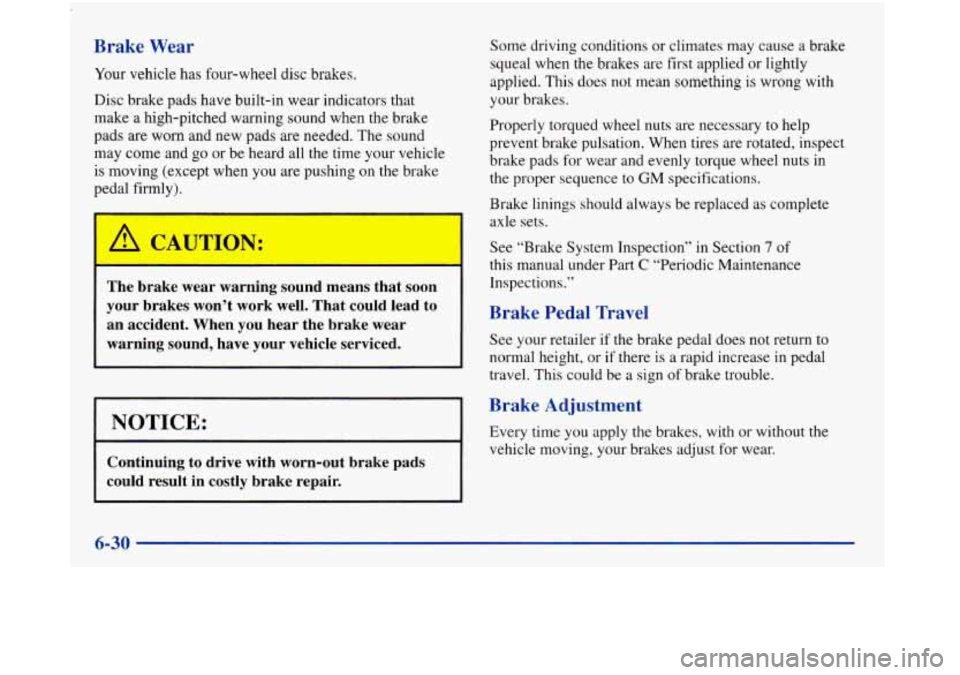
Brake Wear
Your vehicle has four-wheel disc brakes.
Disc brake pads have built-in wear indicators that
make a high-pitched warning sound when the brake
pads are worn and new pads
are needed. The sound
may come and go or be heard all the time your vehicle
is moving (except when you are pushing on the brake
pedal firmly).
A CAUTION:
The brake wear warning sound means that soon
your brakes won’t work well. That could lead
to
an accident. When you hear the brake wear
warning sound, have your vehicle serviced.
I NOTICE:
Continuing to drive with worn-out brake pads
could result in costly brake repair.
Some driving conditions or climates may cause a brake
squeal when the brakes
are first applied or lightly
applied.
This does not mean something is wrong with
your brakes.
Properly torqued wheel nuts
are necessary to help
prevent brake pulsation. When tires are rotated, inspect
brake pads for wear and evenly torque wheel nuts in
the proper sequence
to GM specifications.
Brake linings should always be replaced as complete
axle sets.
See “Brake System Inspection” in Section
7 of
this manual under Part
C “Periodic Maintenance
Inspections.”
Brake Pedal Travel
See your retailer if the brake pedal does not return to
normal height, or if there is a rapid increase in pedal
travel. This could be a sign of brake trouble.
Brake Adjustment
Every time you apply the brakes, with or without the
vehicle moving, your brakes adjust for wear.
6-30
Page 297 of 380

When to Check
Check your tires once a month or more.
Don’t forget your compact spare tire. It should be at
60 psi (420 Wa).
How to Check
Use a good quality pocket-type gage to check tire
pressure. You can’t tell if your tires are properly inflated
simply by looking at them. Radial tires may look
properly inflated even when they’re underinflated.
Be sure to put the valve caps back on the valve stems.
They help prevent leaks by keeping out dirt and moisture.
Tire Inspection and Rotation
Tires should be rotated every 6,000 to 8,000 miles
(10 000 to 13 000 km). Any time you notice unusual
wear, rotate your tires as soon as possible and check
wheel alignment. Also check for damaged tires or wheels.
See “When It’s Time for New Tires” and
“Wheel
Replacement” later in this section for more information.
The purpose
of regular rotation is to achieve more
uniform wear for all tires on the vehicle. The first
rotation is the most important. See “Scheduled
Maintenance Services” in the Index for scheduled
rotation intervals. When
rotating your tires, always use the correct
rotation pattern shown here.
Don’t include the compact spare tire in your
tire rotation.
After the tires have been rotated, adjust the front and
rear inflation pressures as shown
on the Tire-Loading
Information label. Make certain that all wheel nuts
are properly tightened. See “Wheel Nut Torque” in
the Index.
Page 322 of 380
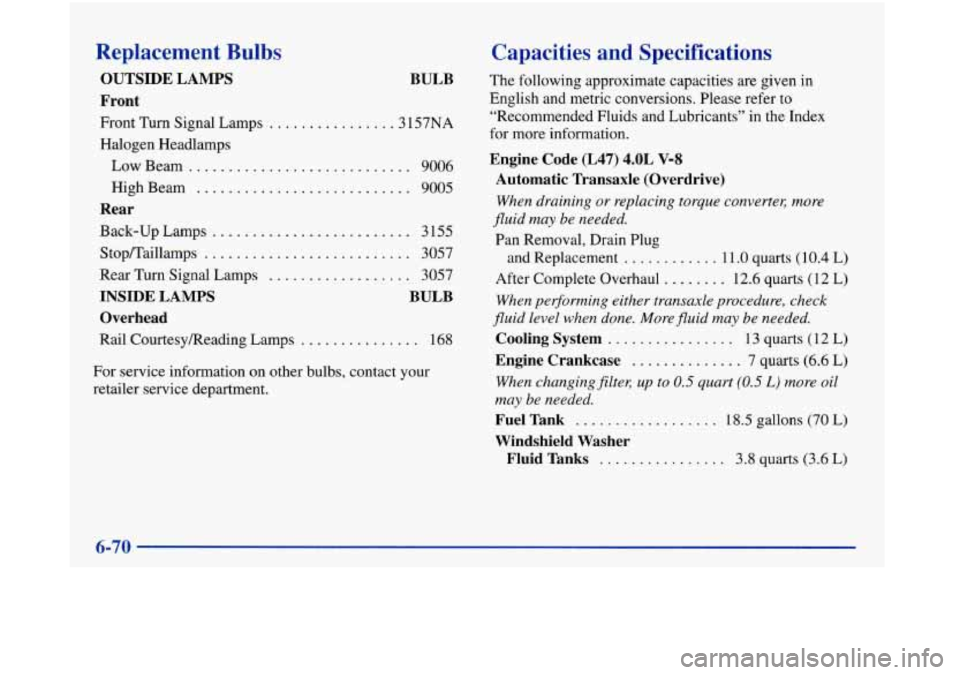
Replacement Bulbs
BULB
OUTSIDE LAMPS
Front
Front
Turn Signal Lamps ............... .3 157NA
Halogen Headlamps
Low Beam
............................ 9006
High Beam
........................... 9005
Rear
Back-up Lamps ......................... 3 155
StopKaillamps
.......................... 3057
Rear
Turn Signal Lamps .................. 3057
INSIDE LAMPS BULB
Overhead
Rail CourtesyReading Lamps ............... 168
For service information on other
bulbs, contact your
retailer service department.
Capacities and Specifications
The following approximate capacities are given in
English and metric conversions. Please refer to
“Recommended Fluids and Lubricants” in the Index
for more information.
Engine Code (L47) 4.0L V-8
Automatic Transaxle (Overdrive)
When draining or replacing torque converteq more
fluid may be needed.
Pan Removal, Drain Plug
and Replacement
............ 11 .O quarts (10.4 L)
After Complete Overhaul
........ 12.6 quarts (12 L)
When per$orming either transaxle procedure, check
fluid level when done. More fluid may be needed.
Cooling System ................ 13 quarts (12 L)
Engine Crankcase .............. 7 quarts (6.6 L)
When changingfllteq up to 0.5 quart (0.5 L) more oil
may be needed.
Fuel Tank .................. 18.5 gallons (70 L)
Windshield Washer
Fluid Tanks
................ 3.8 quarts (3.6 L)
6-70
Page 323 of 380
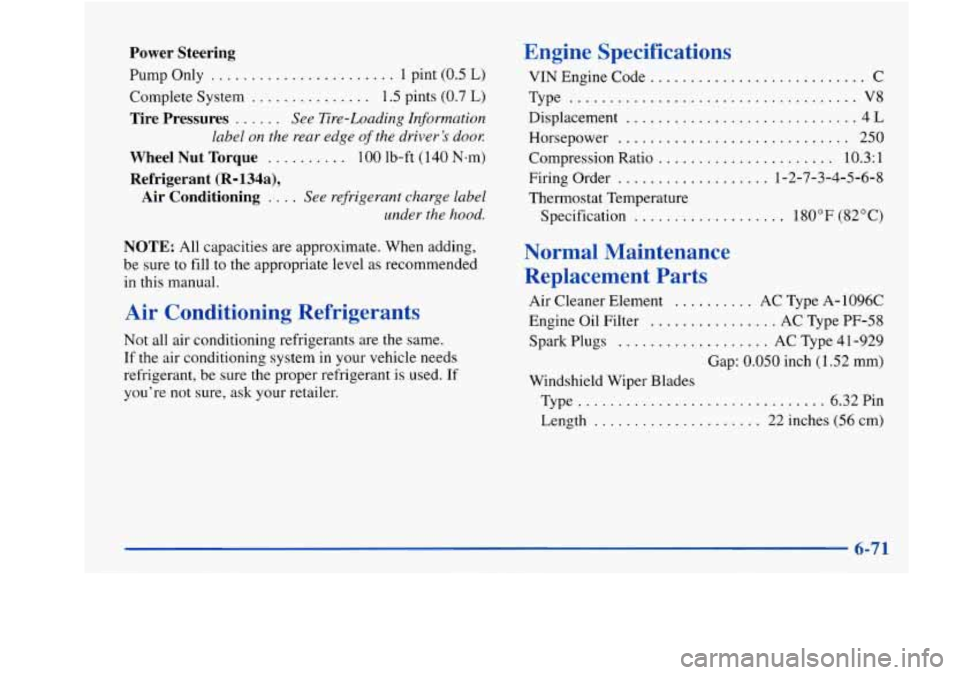
Power Steering
Pump Only ....................... 1 pint (0.5 L)
Complete System ............... 1.5 pints (0.7 L)
Tire Pressures ...... See Tire-Loading Information
label on the rear edge
of the driver’s doox
Wheel Nut Torque .......... 100 lb-ft (140 Nam)
Refrigerant (R=134a),
Air Conditioning
.... See refrigeran.t charge label
under the hood.
NOTE: All capacities are approximate. When adding,
be sure to fill
to the appropriate level as recommended
in this manual.
Air Conditioning Refrigerants
Not all air conditioning refrigerants are the same.
If the air conditioning system
in your vehicle needs
refrigerant, be sure the proper refrigerant is used.
If
you’re not sure, ask your retailer.
Engine Specifications
VIN Engine Code ........................... C
Type
.................................... V8
Displacement ............................. 4 L
Horsepower ............................. 250
Compression Ratio
...................... 10.3: 1
Firing Order ................... 1-2-7-3-4-5-6-8
Thermostat Temperature
Specification
................... 180°F (82°C)
Normal Maintenance
Replacement Parts
Air Cleaner Element .......... AC Type A-1096C
Engine Oil Filter
................ AC Type PF-58
Gap:
0.050 inch (1.52 mm)
Spark Plugs
................... AC Type 4
1-929
Windshield Wiper Blades
Type
............................... 6.32Pin
Length
..................... 22 inches (56 cm)
Page 373 of 380
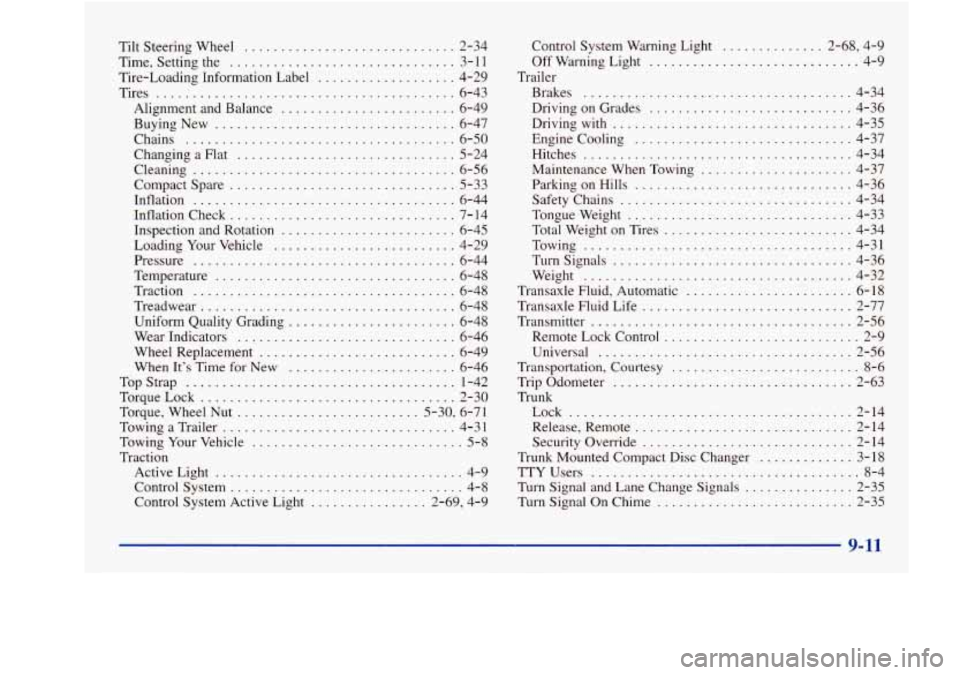
.
Tilt Steering Wheel ............................. 2-34
Time. Setting the
............................... 3-1 1
Tire-Loading Information Label
................... 4-29
Tires
......................................... 6-43
Alignment and Balance
........................ 6-49
BuyingNew
................................. 6-47
Chains
..................................... 6-50
Cleaning
.................................... 6-56
Compact Spare
............................... 5-33
Inflation
.................................... 6-44
Inflation Check
............................... 7- 14
Inspection and Rotation
........................ 6-45
Loading Your Vehicle
......................... 4-29
Pressure
.................................... 6-44
Temperature
................................. 6-48
Traction
.................................... 6-48
Treadwear
................................... 6-48
Uniform Quality Grading
....................... 6-48
Wear Indicators
.............................. 6-46
Wheel Replacement
........................... 6-49
When It’s Time
for New ....................... 6-46
TopStrap
..................................... 1-42
TorqueLock
................................... 2-30
Torque. Wheel Nut
......................... 5-30. 6-71
TowingaTrailer
................................ 4-31
Towing Your Vehicle
............................. 5-8
Traction ActiveLight
.................................. 4-9
Control System
................................ 4-8
Control System Active Light
................ 2-69. 4-9
Changing a Flat
.............................. 5-24
Control
System Warning Light
.............. 2.68. 4.9
Off Warning Light
............................. 4-9
Brakes
..................................... 4-34
Driving on Grades
............................ 4-36
Drivingwith
................................. 4-35
Engine Cooling
.............................. 4-37
Hitches
..................................... 4-34
Maintenance When Towing
..................... 4-37
Parking on Hills
.............................. 4-36
Safety Chains
................................ 4-34
Tongueweight
............................... 4-33
Total Weight on Tires
.......................... 4-34
Towing
..................................... 4-31
Turnsignals
................................. 4-36
Weight
..................................... 4-32
Transaxle Fluid. Automatic
....................... 6-18
Transaxle Fluid Life
............................. 2-77
Transmitter
.................................... 2-56
Remote Lock Control
........................... 2-9
Universal
................................... 2-56
Transportation. Courtesy
.......................... 8-6
Trip Odometer
................................. 2-63
Trunk Lock
....................................... 2-14
Release. Remote
.............................. 2-14
Security Override
............................. 2-14
Trunk Mounted Compact Disc Changer
............. 3-18
TTYUsers
..................................... 8-4
Turn Signal and Lane Change Signals
............... 2-35
Turn Signal On Chime
........................... 2-35
Trailer
9-11
Page 374 of 380
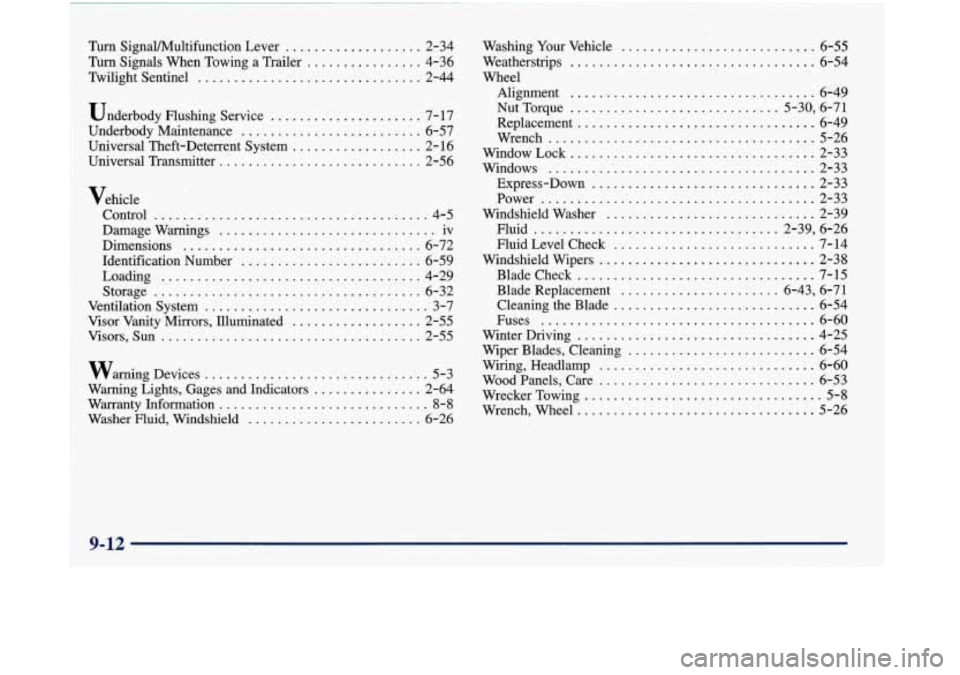
Turn SignaVMultifunction Lever . . . . . . . . . . . . . . . . . . . 2-34
Turn Signals When Towing a Trailer
. . . . . . . . . . . . . . . . 4-36
Twilight Sentinel
. . . . . . . . . . . . . . . . . . . . . . . . . . . . . . . 2-44
underbody Flushing Service
. . . . . . . . . . . . . . . . . . . . . 7-17
Underbody Maintenance
. . . . . . . . . . . . . . . . . . . . . . . . . 6-57
Universal Theft-Deterrent System
. . . . . . . . . . . . . . . . . . 2- 16
Universal Transmitter
. . . . . . . . . . . . . . . . . . . . . . . . . . . . 2-56
Vehicle Control
...................................... 4-5
Damagewarnings
.............................. iv
Dimensions
. . . . . . . . . . . . . . . . . . . . . . . . . . . . . . . . . 6-72
Identification Number
. . . . . . . . . . . . . . . . . . . . . . . . . 6-59
Loading
.................................... 4-29
Storage
..................................... 6-32
Ventilationsystem
............................... 3-7
Visor Vanity Mirrors, Illuminated
. . . . . . . . . . . . . . . . . . 2-55
Visors,Sun
.................................... 2-55
warning Devices
. . . . . . . . . . . . . , . . . . . . . . . . . . . . . . . 5-3
Waming Lights, Gages and Indicators
. . . . . . . . . . . . . . . 2-64
Warranty Information
. . . . . . . . . . . . . . . . . . . . . . . . . . . . . 8-8
Washer Fluid, Windshield . . . . . . . . . . . . . . . . . . . . . . . . 6-26 Washing
Your Vehicle . . . . . . . . . . . . . . . . . . . . . . . . . . . 6-55
Weatherstrips
. . . . . . . . . . . . . . . . . . . . . . . . . . . . . . . . . . 6-54
Wheel Alignment
.................................. 6-49
Nut Torque
. . . . . . . . . . . . . . . . . . . . . . . . . . . . . 5-30,6-71
Replacement
. . . . . . . . . . . . . . . . . . . . . . . . . . . . . . . . . 6-49
Wrench
..................................... 5-26
WindowLock
.................................. 2-33
Windows
...................................... 2-33
Express-Down
. . . . . . . . . . . . . . . . . . . . . . . . . . . . . . . 2-33
Power
...................................... 2-33
Windshield Washer
. . . . . . . . . . . . . . . . . . . . . . . . . . . . . 2-39
Fluid
. . . , . . . . . . . . . . . . . . . . . . . . . . . . . . . . . . 2-39,6-26
Fluid Level Check
. . . . . . . . . . . . . . . . . . . . . . . . . . . . 7-14
Windshield Wipers
. . . . . . . . . . . . . . . . . . . . . . . . . . . . . . 2-38
Blade Check
. . . . . . . . . . . . . . . . . . . . . . . . . . . . . . . . . 7-15
Blade Replacement
. . . . . . . . . . . . . . . . . . . . . . 6-43,6-71
CleaningtheBlade
............................ 6-54
Fuses
...................................... 6-60
Winter Driving
. . . . . . . . . . . . . . . . . . . . . . . . . . . . . . . . . 4-25
Wiper Blades, Cleaning
. . . . . . . . . . . . . . . . . . . . . . . . . . 6-54
Wiring,Headlamp
.............................. 6-60
WoodPanels,Care
.............................. 6-53
WreckerTowing
................................. 5-8
Wrench,Wheel
................................. 5-26
9-12